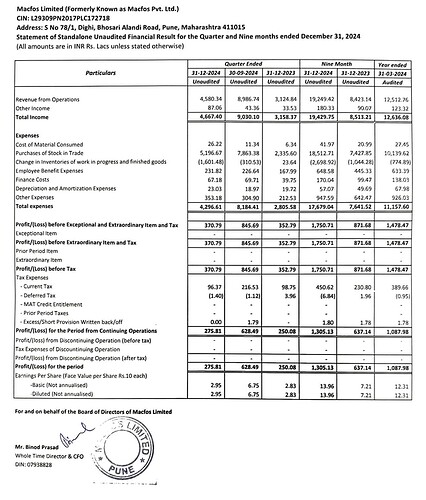Abstract of Presentation
1. Company Overview
- Core Business: Operates as an e-commerce platform specializing in electronic and robotic parts, including components for drones, E-bikes, IoT devices, DIY kits, and more.
- Key Stats:
- Over 30,000 SKUs.
- Partnerships with 210+ vendors domestically and internationally.
- A dedicated 35,000 sq. ft. warehouse with a staff of 200+ (both in-house and contractual).
- Growth: Consistent growth in turnover, EBITDA, and PAT with a CAGR of 67%, 77%, and 88%, respectively, over the last three years.
2. Financial Highlights (H1 FY25)
- Revenue: ₹147.62 crore (+176% YoY).
- EBITDA: ₹15.11 crore (+150% YoY).
- PAT: ₹10.29 crore (+166% YoY).
- Revenue includes a contribution from one-time corporate orders, which are non-recurring. Excluding these, core business revenue grew by 43% YoY.
- Profit Margins:
- EBITDA Margin: 10.23% (compared to 11.28% in H1 FY24).
- PAT Margin: 6.97% (compared to 7.23% in H1 FY24).
3. Key Operational Metrics
- Customer Engagement:
- Total customers served: 80,838 (H1 FY25).
- Average monthly website and app visitors increased from 4.57 lakh (H1 FY24) to 5.27 lakh (H1 FY25).
- Category Revenue Contribution:
- Key categories: Development boards (19.59%), Drone parts (14.85%), 3D printers & parts (13.11%), and batteries & chargers (9.37%).
- Inventory Efficiency:
- Only 3.08% of inventory is very slow-moving (compared to 3.68% as of March 2024).
4. Strategic Priorities
Robu 1.0 (Core Distribution Business):
- Focus on delivering tech products at affordable prices with minimal lead times.
- Expand SKU offerings (added 6,000 new SKUs in H1 FY25).
- Enhance IT infrastructure and optimize supply chain cycles.
Robu 2.0 (Proprietary Products Development):
- Long-term focus on building proprietary brands, particularly in drones, mechanical products, and other electronics.
- Recent developments:
- 53 new SKUs for sensors and modules.
- 46 new SKUs across four new product categories.
- Expanded offerings in tools and drone components.
5. Future Outlook
- Growth Drivers:
- Increased adoption of electronics in daily life and supportive government policies (e.g., Make in India).
- Expanding the customer base, particularly among corporates.
- IT and Operational Enhancements:
- Leveraging ERP systems for operational efficiency.
- Scalable in-house IT infrastructure to support growth.
- Commitment to balancing regular business growth with new opportunities while maintaining sustainable profitability.


